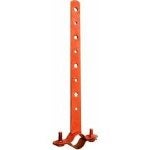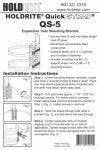Installation and mechanical support of water heater expansion tanks.
INSTALLATION AND SUPPORT OF EXPANSION TANKS - PART 1 of 2:
(Presented in 2 parts due to length restrictions of the forum.)
After doing much research in the past on water heater expansion tank installations, I'd like to share some installation procedures that might be helpful to DIY'ers who want to install one. Some procedures that I thought of are not posted anywhere else that I could find so be aware they are just my own thoughts so use them at your own discretion. Any comments or corrections are welcome.
WHY DO I NEED A WATER HEATER THERMAL EXPANSION TANK?
------------------------------------------------------------------------
See this link for an explanation:
http://www.watts.com/pages/learnAbout/thermalExpansion.asp?catId=64
WHERE TO INSTALL, AND THE ORIENTATION OF THE TANK:
------------------------------------------------------------------
Expansion tanks can be installed anywhere in the plumbing system but that is providing that there is no shut off valve between the expansion tank and the water heater. IOW, when the shut off valve is closed, the expansion tank can still absorb excess pressure created by heating water in the heater.
Some residential expansion tanks will say that they should be installed in a hanging vertical position. But from my research, they can be installed in any orientation. Here's one website that confirms this observation:
http://www.fastwaterheater.com/expansiontanks.htm
The instructions that come with the Watts DET line of expansion tanks say that they can be installed horizontally, or vertically with the water connection on top or on the bottom of the tank.
WHAT KIND OF CONNECTION DOES AN EXPANSION TANK HAVE?
------------------------------------------------------------------------
The Watts DET-12 expansion tank has a 3/4" threaded male fitting. I believe that most if not all residential water heater expansion tanks will have this type of connection.
WHAT KIND OF EXPANSION TANK TO BUY?
------------------------------------------------
For use in a residential plumbing system, be sure to buy an expansion tank that's rated for "potable" water systems. There are expansion tanks for "non-potable" systems and I don't think folks would want to drink water from systems with a non-potable rated expansion tank.
END OF PART 1
INSTALLATION AND SUPPORT OF EXPANSION TANKS - PART 1 of 2:
(Presented in 2 parts due to length restrictions of the forum.)
After doing much research in the past on water heater expansion tank installations, I'd like to share some installation procedures that might be helpful to DIY'ers who want to install one. Some procedures that I thought of are not posted anywhere else that I could find so be aware they are just my own thoughts so use them at your own discretion. Any comments or corrections are welcome.
WHY DO I NEED A WATER HEATER THERMAL EXPANSION TANK?
------------------------------------------------------------------------
See this link for an explanation:
http://www.watts.com/pages/learnAbout/thermalExpansion.asp?catId=64
WHERE TO INSTALL, AND THE ORIENTATION OF THE TANK:
------------------------------------------------------------------
Expansion tanks can be installed anywhere in the plumbing system but that is providing that there is no shut off valve between the expansion tank and the water heater. IOW, when the shut off valve is closed, the expansion tank can still absorb excess pressure created by heating water in the heater.
Some residential expansion tanks will say that they should be installed in a hanging vertical position. But from my research, they can be installed in any orientation. Here's one website that confirms this observation:
http://www.fastwaterheater.com/expansiontanks.htm
The instructions that come with the Watts DET line of expansion tanks say that they can be installed horizontally, or vertically with the water connection on top or on the bottom of the tank.
WHAT KIND OF CONNECTION DOES AN EXPANSION TANK HAVE?
------------------------------------------------------------------------
The Watts DET-12 expansion tank has a 3/4" threaded male fitting. I believe that most if not all residential water heater expansion tanks will have this type of connection.
WHAT KIND OF EXPANSION TANK TO BUY?
------------------------------------------------
For use in a residential plumbing system, be sure to buy an expansion tank that's rated for "potable" water systems. There are expansion tanks for "non-potable" systems and I don't think folks would want to drink water from systems with a non-potable rated expansion tank.
END OF PART 1













